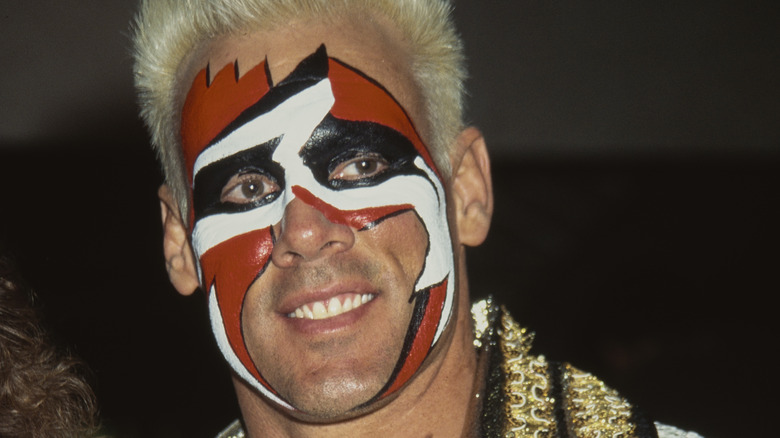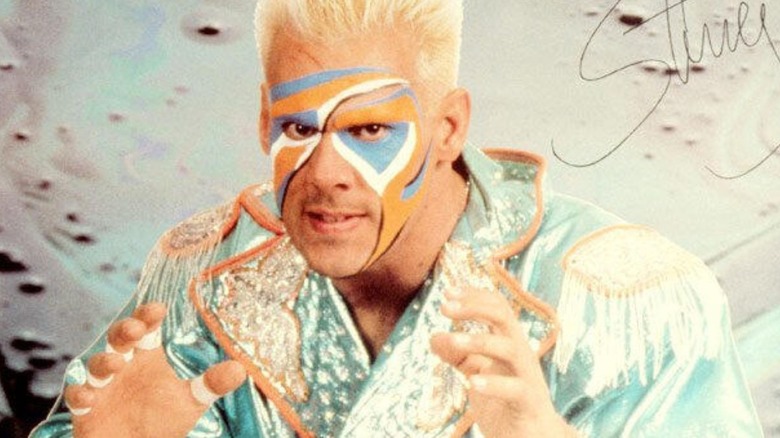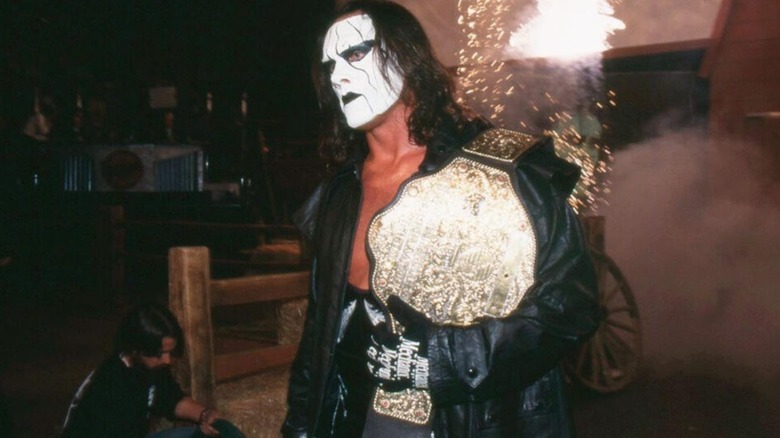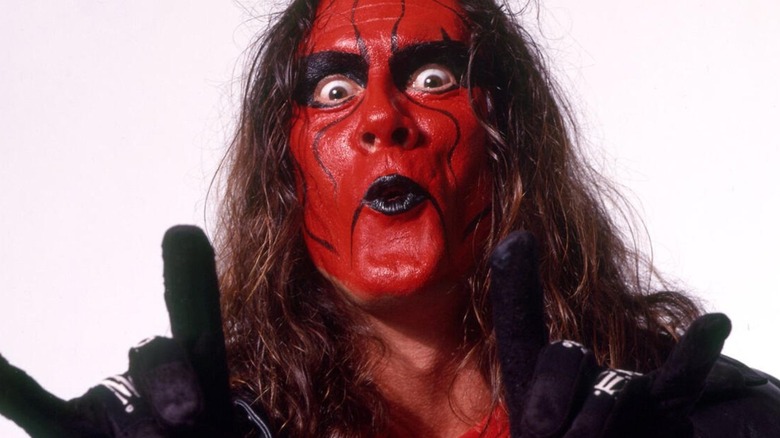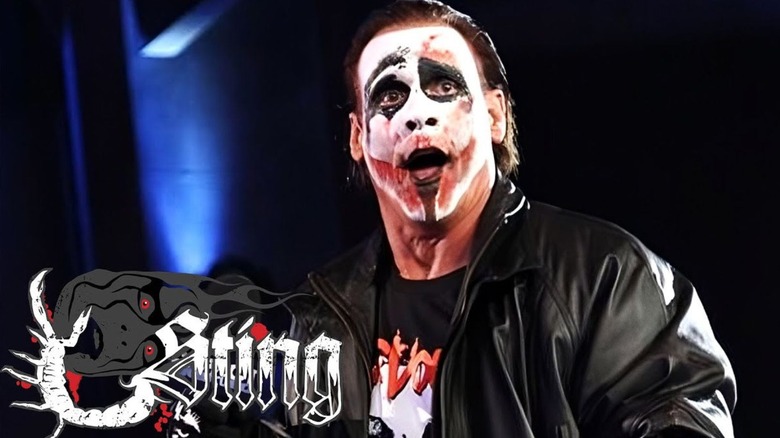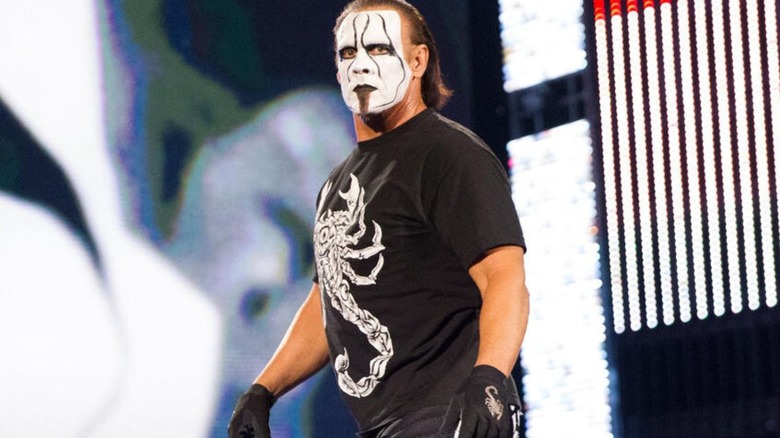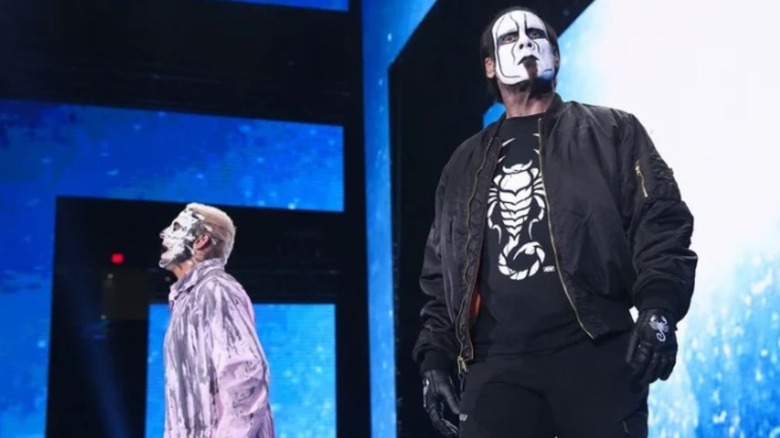The Incredible Transformation Of The Icon Sting
Sting may have retired from professional wrestling at AEW Revolution 2024, but "The Icon" and the man often known as the "Franchise of WCW" is still the talk of the wrestling world, with many of his colleagues sharing memories of Stinger's time in the business, as well as fans sharing their own stories. The man known as Steve Borden in real life had an extensive career, not just in WCW, but in TNA, and eventually WWE for a short time, before leaving his boots in the ring in AEW.
The transformations Sting went through throughout his career, which began in the Continental Wrestling Association in 1985 before he broke into mainstream wrestling with the NWA/WCW in 1988, are vast. Before being known as "The Icon" in his black-and-white face paint and tights adorned with his now-signature scorpion, he was in what's known as his "Surfer" era, with bleached blonde hair and colorful face paint.
Sting also went through a phase in TNA where he focused more on a supervillain look, à la The Joker. There weren't many times Sting was seen without face paint, his induction into the WWE Hall of Fame being one. Though he may be gone from our TV screens for a while, we're taking a look back at "The Icon's" iconic transformations.
SURFER STING
After getting into professional wrestling through CWA and the Universal Wrestling Federation, Sting found success quickly in the NWA, part of Jim Crockett Promotions. Sting's look at the beginning of his career was quite different than what younger fans know today.
His hair was bleached blonde and he wore fun, bright colors to the ring. It's a look that became known as "Surfer Sting" in later years, as Borden was raised in southern California. He ran with the brighter look from the late '80s through 1996.
"Surfer" Sting's highlight match at this point of his career was the first Clash of the Champions main event. He faced Ric Flair for the NWA World Championship, and the two battled to a time-limit draw. During this period of his career, he ended up teaming with Flair, even eventually becoming a member of the equally as iconic Four Horsemen. Sting also took his bright look overseas, wrestling a brief tour in All Japan Pro Wrestling. Sting rocked the surfer look through WCW seceding from the NWA.
CROW STING
Beginning in 1996 in WCW, Sting started to take on a darker look. His bleached hair was no more and he started to grow it long in his natural, dark color. He began wearing tights with a multi-colored scorpion, before he started rocking black gear, as well. The darker look was created to combat the invading NWO. Sting recalled that crowds began to turn on the equally as colorful and blonde Hulk Hogan, and he knew he needed a change in his character as well.
The darker Sting character began feuding with Kevin Nash and Scott Hall, who had just arrived in WCW after leaving WWE, in summer 1996. When Hogan appeared at Bash at the Beach to help Hall and Nash against Sting, Lex Luger, and Randy Savage, he declared a "new world order" in professional wrestling, and Sting became a threat to the now-established NWO.
As the feud continued, Sting became the silent vigilante he would be most remembered for, not speaking on WCW programming for months. He began carrying around his baseball bat, a weapon now as iconic to Sting as the black and white face paint, which he also started utilizing more at this time. He also began watching the action of WCW from the rafters, before he eventually began to rappel down to attack members of the NWO. Sting modeled this look after the main character, Eric Draven, from the movie "The Crow," on the advice of Hall.
NWO WOLFPAC
When Hogan's NWO began to break apart in 1998, the look of Borden's character changed once again. When Nash and Savage split from the original faction and formed the NWO Wolfpac, Sting joined them as well. He appeared to have joined Hogan's heel faction at the time when he appeared wearing a black and white NWO shirt, but tore it off to reveal the Wolfpac's signature black and red. While involved with the stable, Sting started to wear red and black face paint.
Sting didn't stay in his black and red Wolfpac-inspired face paint for long, however. He was taken out at Halloween Havoc by Bret Hart. The two were feuding over their similar finishers, Sting's Scorpion Deathlock versus Hart's Sharpshooter, and Hart took Sting out with a baseball bat. Sting was on the shelf for several months. When he returned to "WCW Nitro" in March 1999, the NWO storylines had faded and he was not brought back to any of its iterations. Sting returned to the company as his "Crow" character, once again sporting black and white face paint, with the NWO Wolfpac simply a memory and notch in his career full of transformations.
In 2001, Sting had a transformation of a different kind in his career, with WWE's Vince McMahon purchasing WCW. WWE chose not to buy out Sting's contract, and he also rejected a buyout offer from Time Warner, opting to wait for his WCW contract to expire in March 2002. Sting decided not to join WWE and went on a hiatus for almost two years, before joining World Wrestling All-Stars for a short stint.
TNA & JOKER STING
Outside of WCW, Sting's longest and one of his most memorable runs within professional wrestling happened with TNA. Sting signed with TNA in 2003, initially just for a handful of appearances, but later went on to sign with the company full-time. His most remembered face-painted look from his time in the promotion was a clear depiction of Heath Ledger's Joker from the Christopher Nolan Batman film "The Dark Knight."
Sting donned the maniacal paint and character arc to combat Hulk Hogan and Eric Bischoff, who had also signed with the promotion. In the storyline, Sting warned others of the issues the heel pair would cause and slowly descended into madness as no one would listen. With the Joker-esque paint, Sting became known as the "Insane Icon."
The Joker Sting character ran its course after "The Insane Icon" turned Hogan into a babyface at Bound for Glory 2011, which ended up being his mission after all. The gimmick was dropped following the show, and Sting returned to his iconic "Crow" face-painted form. Sting has said in interviews this was his favorite iteration of his character. Prior to this now-fondly remembered Joker character in 2009, Sting was also a member of the Main Event Mafia, alongside Kurt Angle, Scott Steiner, Booker T, and Kevin Nash, and he would often appear in a business suit sans-face paint, or even looking professional while wearing his black and white make-up. Sting left TNA at the beginning of 2014 after losing a "Title vs. Career" match to Magnus.
WWE & RETURN OF THE CROW
Something that WCW fans never thought they would see, especially as "The Icon" aged, Sting signed with WWE in 2014, and his first appearance on WWE programming came that November. He appeared during the main event of Survivor Series and attacked Triple H, hitting "The Game" with a Scorpion Death Drop. Sting didn't appear on WWE TV until an episode of "WWE Raw" in January 2015, where he began feuding with The Authority.
During his time in WWE, Sting solely went with his signature black-and-white face paint, delighting those who had been fans of "The Icon" since his later WCW days. Sting would challenge Triple H to a match at WrestleMania 31 and continued to make surprise appearances before the event, speaking on the mic for the first time in WWE in March, in a segment that wasn't televised. He lost his first WWE match at WrestleMania.
Sting had just four matches in WWE. His last match came at Night of Champions when he challenged WWE World Heavyweight Champion Seth Rollins. Sting was injured by Rollins when "The Icon" took a buckle bomb into the turnbuckle. He retired after what he called a "freak accident." Sting was announced at the first member of the 2016 WWE Hall of Fame Class
AEW & STING'S ICONIC LOOK
Perhaps even more shocking than Sting's signing with WWE, was his return to the ring following the neck injury that led to his retirement. "The Icon" signed with AEW in December 2020. He rescued Darby Allin, who would go on to become Sting's tag team partner, from Ricky Starks and "Powerhouse" Hobbs. He made his in-ring debut in the company at Revolution 2021, teaming with Allin to face Brian Cage and Ricky Starks in a cinematic Street Fight. Sting and Allin would go on to team throughout the former's entire run with the company, as Sting mentioned he was not in the condition to be wrestling singles matches.
In October 2023, "The Icon" announced his impending retirement. Sting decided to retire where he began his AEW career, at Revolution, which took place in Greensboro, North Carolina. He retired on top, when he and Allin, who had won the AEW World Tag Team Championship from Big Bill and Ricky Starks on an episode of "AEW Dynamite," defeated the Young Bucks at Revolution. Sting officially retired from professional wrestling, with his iconic "Crow Sting" black and white look, in Greensboro, having been undefeated alongside Allin in AEW.
In his WWE Hall of Fame induction speech, Stinger said that "the only thing that's for sure is that nothing is for sure," so his involvement in the wrestling landscape, outside of the ring, could be far from over. Fans of "The Icon" will have to wait and see what transformation Sting goes through next.
